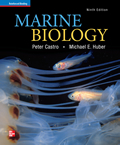
Marine Biology (Castro), 9th EditionChapter 7: Marine Animals Without a BackboneDo It Yourself SummaryRead each sentence and identify the word/phrase that you believe correctly completes the statement. Then, click on the arrow to see if your answer is correct.1. Sponges are considered structurally simpler than most other multicellular animals because they lack true and . 2. The presence of nematocysts and radial symmetry are fundamental characteristics of . 3. In symmetrical animals, the body displays a surface different from a ventral one and an end, usually a head, differentiated from a posterior end. 4. Examples of bilaterally symmetrical worms are the , which lack an anus as in cnidarians, and the , a large group common in marine sediments that may consist of as many as half a million species. 5. Annelids, the segmented worms, have a body cavity called a , which acts as a hydrostatic skeleton. 6. Molluscs are characterized by a soft body and by two structures that are sometimes absent: a calcareous, external or internal and a , a chitinous structure in the mouth region used in feeding. 7. An exoskeleton and paired, appendages characterize members of the phylum . The great majority of the marine representatives of this phylum belong to one group, the . 8. Echinoderms are unique in several ways. Besides their symmetry, locomotion and sometimes feeding are carried out by means of the or . 9. Only relatively few chordates lack a backbone. Nevertheless, all chordates during at least some stage of their lives have small openings in the anterior part of the gut called (or ), a flexible for support, and a single nerve cord. 10. Mollusks that do not have a shell may protect themselves by producing or . |  |















